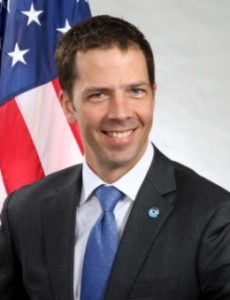NOAA official hosting public listening session in Madison
CONTACT: Keli Pirtle, keli.pirtle@noaa.gov, 405-203-4839
MADISON – Neil Jacobs, assistant secretary of commerce for environmental observation and prediction at the National Oceanic and Atmospheric Administration (NOAA), will be in Madison on Nov. 26 to gather public input on the Department of Commerce’s 2018-2022 Strategic Plan and the Weather Research and Forecasting and Innovation Act of 2017.

Neil Jacobs, NOAA assistant secretary of commerce for environmental observation and prediction. Credit: NOAA
The listening session will be held on the University of Wisconsin–Madison campus at Union South Varsity Hall (1308 W. Dayton St.) from 2:30 p.m. until 4:00 p.m. Jacobs plans to discuss NOAA’s efforts to improve the translation of weather research to operations, to develop a community-based weather model, and to advance seasonal-to-subseasonal weather forecasts.
His remarks will be followed by a period for public comments. This is an opportunity to ask questions and provide input on implementation of these and other NOAA and Department of Commerce priorities. One goal of the Strategic Plan is to strengthen U.S. economic and national security by reducing the effects of extreme weather through implementation of the Weather Act.
“The Weather Act is, in part, focused on obtaining better observations,” says UW–Madison Associate Vice Chancellor Steve Ackerman, who is also director of the Cooperative Institute for Meteorological and Satellite Studies (CIMSS). “This is an area of expertise here at the UW – better observations will help us continue to improve the accuracy of forecasts and extend them beyond seven days.”
In fact, he adds, the U.S.’s newest weather satellite, GOES-17, is experiencing problems with one of its instruments, preventing scientists from using the observational data. Scientists at the CIMSS are working side-by-side with NOAA scientists to find a solution to the problem.
With more than 50 CIMSS-developed algorithms in use by the NOAA National Weather Service (NWS), CIMSS has a demonstrated track record of transitioning forecasting tools that incorporate improved observations from the research environment to the NWS operational environment.
Currently, CIMSS researchers are developing and testing a new forecasting model in support of the Next Generation Global Prediction System, an NWS initiative to improve forecasts and address growing service demands, another piece of the Weather Act.
There aren’t many universities running this model, says Ackerman, professor of atmospheric and oceanic sciences.
“It’s an honor to have NOAA leadership visiting campus,” he says. “It acknowledges our history and expertise in this area of science and recognizes that we have important contributions to make that support NOAA objectives and weather forecasting.”
Doors for the event open at 2:00 p.m. It is free and open to the public. Media interested in viewing the public session or interviewing the NOAA speaker must RSVP to listen.sessions@noaa.gov by 4:00 p.m. CDT on Sun., Nov. 25.
# # #
— Jean Phillips, jean.phillips@ssec.wisc.edu
